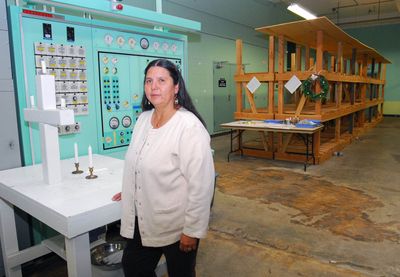Tribe hopes to re-create early village
Port Angeles, Wash., site unearthed during state work

PORT ANGELES, Wash. – Deep inside a Cold War-era building where bare lights shine on a stained concrete floor, a tomb stands empty.
Sturdily built wooden racks which once held more than 300 handmade cedar boxes are bare, the racks’ burdens buried Sept. 14 and Sept. 15 at Tse-whit-zen.
The boxes hold the intact and isolated remains of persons who once lived in the crook of Ediz Hook.
Meanwhile at that ancestral village and cemetery, members of the Lower Elwha Klallam Tribe plan to continue leveling the site of the former Hood Canal Bridge graving yard.
Then they’ll landscape it with grass and flowering native plants.
“We want it to look like a nice, kept-up cemetery,” Tribal Council member Russell Hepfer said.
Eventually, the Lower Elwha plan to build a cultural center and museum on land it leases at low cost from the state.
Ultimately, they’d re-create Tse-whit-zen as it stood before it was razed for a sawmill early in the last century.
The tribe has no set schedule for the projects. “It’s not ‘Indian time,’ ” Hepfer said. “It’s when everything is ready.”
The Lower Elwha say they’re rewriting history.
“By utilizing what we have, rediscovering it, we’re changing the Columbus account that I grew up on,” said Tribal Chairwoman Frances Charles.
“We have that opportunity to change the curriculums, to talk about our history, from kindergarten all the way up to the college level.”
The journey isn’t one the Lower Elwha wanted to start in August 2003, when graving yard contractors dug into the 2,700-year-old Klallam village.
Although crews began finding artifacts and human bones within weeks, the project was not shut down until December 2004, after a tense, emotional clash of cultures involving the tribe, the city of Port Angeles and state and federal officials.
“If we could have done what we needed to do, none of us would have been faced with the realities we’ve dealt with,” Charles said.
“If our people had the capability and laws we have now (that protect Native American cemeteries), our ancestors never would have allowed that to happen.”
Besides leveling and landscaping, the Lower Elwha say they still have lots to do at Tse-whit-zen.
“We have so many more of the piles we have to screen through,” Charles said about the tarpaulin-covered mounds of earth that stand around the 22 1/2 acres.
Even the dirt with which the cedar caskets were covered bore fragmentary remains, she said.
“It will take I don’t know how many years to go through the piles that have high probability, medium probability and low probability of isolates and artifacts,” Hepfer said.
The Lower Elwha don’t voice any pleasure over stopping the state Department of Transportation from completing the graving yard.
Despite the anger that greeted the tribe’s terminating the project, local businesses sold tools for the reburial – shovels, wheelbarrows and other equipment – to the tribe at reduced prices.
“I really want to say thanks,” Charles said. “The local businesses have really stepped forward.”
And the tribe is proud that it emerged from the controversy with what it wanted: To return the ancestors to their final resting place.
“We could take care of all the wrongs, all the disturbances over the years, all the mills, all the digging them up and throwing them back,” Tribal Council member Phil Charles said.
“It brought us as a community together to a conclusion to take care of our ancestors and not allow them to be disturbed anymore.”
Added Hepfer: “I believe this tribe can do anything. It shows other tribes that they can step up and do things, too.”
The experience also illustrated the Native American maxim that decisions should be made to benefit the next seven generations.
By one calculation, that’s as much time as has elapsed since the tribe signed the Treaty of Point No Point in 1855.
For now, the Lower Elwha Klallam will consider what they’ll do with Tse-whit-zen once the site is regraded.
“It’s going to be a place we’ll be able to visit with our ancestors,” Frances Charles said.
They also want to recreate their ancestors’ home.
“We have a lot of preparation for what we visualize as a village down there, to reconstruct what the village would have looked like.
“We all have a mental picture of how we’d like to see it, but we have to collaborate with everybody’s thoughts.
“These are things we want to design so we can show our kids and our community.”